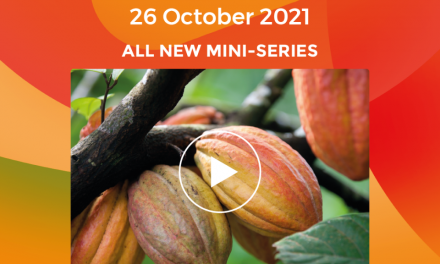California Walnuts have been in the headlines as a naturally delicious superfood, rich in protein and fibre and the only tree nut providing a significant amount of the plant-based omega-3 ALA.
California walnuts are incredibly flexible as an ingredient and enhance the taste and texture of a wide range of products including confectionery. The California walnut industry is continually researching how walnuts can be used in such products as nut butters and sauces and main meals and is working on ways to improve the shelf-life of walnuts and preventing their deterioration during the production process. Walnuts are increasingly being used by small and large manufacturers in a variety of countries around the world, from nut butters, flavoured walnuts and in the US, confectionery.
Peter Meadows from The Garden Marketing & PR, the trade representative for California Walnuts in the UK, gives the British perspective: “We are moving into an era of ‘smart’ confectionery which delivers on health and added value, and these concepts are now an accepted part of the category.
“As one of the best plant food sources of omega-3s, a 30-gram handful of California walnuts provides 2.7 grams of ALA, 4 grams of protein and 2 grams of fibre”
Alongside their category-defining sweet treats, large manufacturers like Kellogg’s and Mondelez and a host of smaller players are offering a wider choice to the growing number of consumers who are becoming more discerning and want products with nutritional ingredients that give clear health benefits. With their high omega-3 content, California walnuts fit beautifully into this scenario.”
Sweet success stories
In the UK, one of the most famous confectionery products featuring walnuts is the Walnut Whip, launched in 1910 by Duncan’s of Edinburgh and now Nestlé Rowntree’s longest established brand. Over one million walnuts are used every week in producing Walnut Whips and California has played a key role over the years in supplying quality walnuts for their production. As an important part of the visual appeal of the product, the walnut placed on top of the Walnut Whip must be of the highest quality and it is a celebrated part of the entire ‘walnut whip’ visual and taste experience.
Happy together
Chocolate and California walnuts are a perfect pairing as California walnuts have a mild flavour, so in couverture chocolate the taste is very subtle. Walnuts are significantly softer and the nut itself is creamier, creating a pleasing crunch and unique taste experience.
California Walnuts are ideal for use in confectionery to other walnut origins because the Central Valley in California provides ideal conditions to grow premium quality walnuts sustainably. With a sweet-mild taste and a soft creamy texture, California walnuts offer a winning combination of great taste, consistently high quality, exceptional food safety, and availability all year round.
Unforgettable chocolate experiences
Other ingredient suppliers talk about ‘clean label,’ but in many cases turn their foods into something different from what they were originally. California walnuts retain their natural integrity right the way through. California walnuts are naturally protected against contamination thanks to the ‘double shell envelope’ the nut has whilst on the tree
It’s a long road from planting a walnut orchard to delivering fresh, delicious walnuts to your local market. Find out about the process from tree to table, and the strict food quality and safety standards that regulate the walnut industry.
Each step in the process from propagation, to harvest, to packer, and finally to market is handled with care and attention. There are 4,000 walnut growers, a large majority being family farms, many of which have been in the walnut business for several generations, and approximately 75 handlers.
Walnut production takes commitment and patience, and orchards are dedicated only to walnut production. After a walnut sapling is planted, it takes five to seven years for it to grow into an adult tree suitable for harvesting. Although many varieties of walnuts are grown in California, six varieties account for over 85%: Chandler, Hartley, Howard, Tulare, Serr, and Vina.
Harvesting
Harvesting begins in late August, when the drying green hulls start to split (allowing the inshell walnuts to be removed) and continues until late November. First, the orchard floor is swept clean. Then, mechanical shakers vigorously shake each tree and thousands of walnuts fall to the ground. The walnuts are carefully swept into windrows to allow mechanical harvesters to pick them up for cleaning.
Processing
The outer green husk is removed by a huller and the nut is mechanically dehydrated (air-dried) to the optimum 8% moisture level. This prevents deterioration of the nut and protects its quality during storage. Walnuts are stored until needed for cracking. California walnuts are protected from contamination because of the nut’s double envelope of hull and shell while on the tree.
Walnut Packing
Walnuts are transported to a packing plant where they are graded into two distinctive markets, inshell and shelled.
In shell Walnuts
Following drying, sizing of the in-shell nut occurs. Inshell walnuts are sized as jumbo, large, medium, or baby according to USDA standards.
Shelled Walnuts
Walnuts for both consumer and industrial use are removed from storage as needed and sent to the shelling department where they are mechanically cracked. The shelled material is screened. Kernels are screened into a series of sizes, air-separated from shells, and moved through electronic colour graders and shell sorters.
Finally, they are hand-sorted by trained sorters and certified by for quality and USDA standards; then, they are ready for packing.
Once shelled, walnut kernels are physically inspected to ensure an end product that is clean, well-dried, and of specified colour, as determined in comparison to the official walnut colour chart.
Tolerances for total and special defects are specified for each grade. Laboratory tests, both chemical and microbiological, are conducted to meet strict regulatory agency and food safety requirements.
California Walnuts Meet Strict Quality Control Standards
California walnuts are produced under stringent quality controls that exceed California inspection standards, reputed to be the world’s toughest. Handlers also meet individual customers’ standards and specifications. Many cutting-edge technologies are harnessed during the process in a sustained effort to bring consumers walnuts of uncompromising quality.
The walnuts are grown and processed under the strict regulation of the California Walnut Board, USDA/DFA and the US Food and Drug Administration (FDA). A food safety control program and quality control regime (HAACP) are in place that meets the standards imposed by all regulatory authorities.
Packaging
California walnuts are produced in a wide variety of sizes, colour grades and combinations of sizes and colours to meet the specifications of any industrial formulation. Commercial products meet the same high standards of quality as those sold directly to the consumer.
California Walnuts should be kept refrigerated for use within six months, or frozen for longer storage. If you require further advice, or assistance please contact; https://www.californiawalnuts.co.uk/trade-contact/







